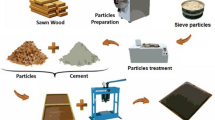Abstract
In this study, the use of ligno-cellulosic materials (Pistachio, Pomegranate, Cotton Stalks, Haloxylon species), to produce lightweight construction blocks is reported. Three load of Portland cement, Type II (65, 70, 75 % w/w wood), three levels of additives as cement setting accelerator (CaCl2 (3 % w/w cement), CaSo4 (5, 10 % w/w cement)) were considered as variables (9 treatments). Three replications were fabricated for each treatment and the physical and mechanical properties of the blocks were evaluated according to ASTM D-1037. Bulk densities of blocks varied from 0.96 to 1.17 g/cm3. Significant difference was found between cement content and also between CaCl2 and CaSo4 content in compressive strength. There was non-significant difference between cement content and also between CaCl2 and CaSo4 content in water absorption and thickness swelling. There was the lowest water absorption and thickness swelling for 75 % cement content and 3 % CaCl2 content in the wood- cement blocks.



Similar content being viewed by others
References
Aggarwal LK (1992) Studies on cement-bonded coir fibers board. Cem Concr Compos 14:63–69
Aggarwal LK, Agrawal SP, Thapliyal PC, Karade SR (2008) Cement-bonded composite boards with arhar stalks. Cem Concr Compos 30(2008):44–51
Ajayi B (2003) Investigation of the dimensional stability of cement-bonded composite boards fabricated from coffee husks. Niger J For 33(2):88–93
American society for testing and materials (1999) Standard methods of evaluating the properties of wood-base fiber and particle panel materials. ASTM D 1037-96a. ASTM, West Conshohocken, Pa. USA
Aro M (2008) Wood strand cement board. In 11th international inorganic-bonded fiber composites conference, Madrid, Spain. pp 169–179
Asasutjarit C, Hirunlabh J, Khedari J, Charoenvai S, Zeghmati B, Shin UC (2007) Development of coconut coir-based lightweight cement board. Constr Build Mater 21(2):277–288
Ashori A, Tabarsa T, Azizi K, Mirzabeygi R (2011) Wood–wool cement board using mixture of eucalypt and poplar. Ind Crop Prod 34(1):1146–1149
Ashori A, Tabarsa T, Sepahvand S (2012) Cement-bonded composite boards made from poplar strands. Constr Build Mater 26:131–134
Bowyer JL, Stockman V (2001) Agricultural residues: an exciting bio-based raw material for the global panel industry. For Prod J 51(1):10–21
Juhany L, Aref I, Wakeel A (2003) Evaluation of using some available lignocellulosic agricultural residues in manufacturing wood-cement boards in Saudi Arabia. Proc Int Conf Date Palm 281:291
Khorami M, Ganjian E (2011) Comparing flexural behavior of fiber–cement composites reinforced bagasse: wheat and eucalyptus. Constr Build Mater 25(9):3661–3667
McNutt JΑ, Haegglom R and Raemoe K (1992) The global fiber resource Picture. Wood product demand and the environment. A forest products research society international conference proceedings: 39–53
Ntalos G (2000) Utilization of lignocellulosic residues of agricultural plants for the construction of wood adhesive components. Ph.D. dissertation. Aristotelian University of Thessaloniki
Olesen PO and Plackett DV (1999) Perspectives on the Performance of Natural Plant Fibres. Natural fibres performance forum plant fibre products-essentials for the future, Copenhagen Denmark, 27–28 May 1999
Strength O (2006) water absorption characteristics of cementbonded particleboard produced from coconut husk. J Civil Eng Res Pract 3(1):41–49
Youngquist J, English Α, Brent E, Scharmer R, Chow P and Steven R (1994) Literature review on use of nonwood plant fibers for building materials and panels. Gen.Tech.Rep. FPL-GTR-80. Madison, WI: U.S. Department of Agriculture
Author information
Authors and Affiliations
Corresponding author
Rights and permissions
About this article
Cite this article
Kamali Moghadam, S., Shamsian, M., Moeel Tabaghdehi, F. et al. Investigation on physical and mechanical properties of wood-cement block manufactured from agriculture residues and Haloxylon species. J Indian Acad Wood Sci 11, 134–139 (2014). https://doi.org/10.1007/s13196-014-0129-8
Received:
Accepted:
Published:
Issue Date:
DOI: https://doi.org/10.1007/s13196-014-0129-8




